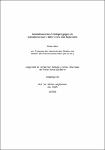Neutralisierende Antikörper gegen die transmembranen Hüllproteine von Retroviren
Langhammer, Stefan
Mehr als 20 Jahre nach der Entdeckung des Erregers der zu der Immunschwächekrankheit AIDS führt, ist es trotz verstärkter internationaler Bemühungen nicht gelungen einen erfolgreichen Impfstoff gegen das HI-Virus zu entwickeln. Die Aminosäuresequenz des transmembranen Hüllproteins gp41 von HIV-1 beinhaltet zwei Epitope die von den monoklonalen Antikörpern 2F5 und 4E10 erkannt werden. Diese beiden Antikörper wurden aus HIV-1 infizierten Patienten isoliert und zeigen ein subtypübergreifendes HIV-1 Neutralisationsspektrum. Bis zum heutigen Zeitpunkt ist es nicht gelungen Antikörper mit einer entsprechenden Spezifität durch aktive Immunisierung zu induzieren. Bedingt durch den hohen Konservierungsgrad der Aminosäuresequenz in verschiedenen HIV-1 Subtypen stellt das gp41 Protein ein viel versprechendes Ziel in der HIV-Impfstoffentwicklung dar. In der vorliegenden Dissertationsarbeit ist die humorale Immunantwort gegen das transmembrane Hüllprotein p15E des γ-Retrovirus FeLV-A (Felines Leukämie Virus Subtyp A) in verschiedenen Spezies charakterisiert worden. Dabei konnten zwei immundominante Epitopregionen beschrieben werden (E1 und E2), die von virusneutralisierenden Antikörpern erkannt werden. Eine dieser Epitopregionen ist, ähnlich dem 2F5 und dem 4E10 Epitop in gp41 Protein, im C-terminalen Bereich des transmembranen Hüllproteins lokalisiert. Für das E2 Epitop von FeLV-A p15E konnte eine partielle Sequenzhomologie mit dem 4E10 Epitop nachgewiesen werden. Weiterhin konnte gezeigt werden, dass die Immunisierung von Katzen mit FeLV-A p15E vor einer produktiven Infektion schützen kann und dass hier die Induktion einer protektiven Immunität nicht von einer sterilisierenden Immunität abhängig ist. Diese Arbeit ist die erste Dokumentation die den Schutz vor einer produktiven retroviralen Infektion durch Immunisierung mit dem entsprechenden transmembranen Hüllprotein zeigt. Auf der Grundlage des erarbeiteten Modells der humoralen Immunantwort gegen das p15E Protein von FeLV-A wurden zwei Hybridkonstrukte exprimiert, die auf der Aminosäuresequenz des p15E Proteins basieren und eine C-terminale Aminosäuresequenz mit den Epitopen von 2F5 und 4E10 aus HIV-1 gp41 enthalten. Durch die Immunisierung von Ratten mit einem der beiden Konstrukte konnten HIV-1 neutralisierende Antikörper gegen den homologen Virustyp, sowohl als auch gegen Primärisolate induziert werden. Die Titer der HIV-1 neutralisierenden Antikörper entsprachen denen, die mit FeLV-A p15E in Ratten induziert werden konnten. Die Antikörper in den entsprechenden Immunseren erkannten Epitope in der gp41 Aminosäuresequenz, die entweder kurz vor, oder innerhalb der Epitope von 2F5 oder 4E10 lokalisiert waren. Bedingt durch die Tatsache, dass in der Vergangenheit weder durch Immunisierungen mit gp41-abgeleiteten Peptiden, noch mit gp41- Proteinen von HIV-1, neutralisierende Antikörper induziert werden konnten, kann davon ausgegangen werden, dass die Konformation des hier beschriebenen Hybridproteins dafür verantwortlich ist. Das hier beschriebene Hybridprotein könnte die Grundlage für einen effizienten HIV-1 Impfstoff darstellen. The development of an effective HIV vaccine is more than 20 years after the first description of the virus inducing AIDS one of the major targets in international health efforts. Conventional vaccine strategies including attenuated whole virus vaccines or recombinant viral proteins failed due to safety concerns or ineffective immunological responses. Thus the induction of neutralising antibodies against the HIV-1 transmembrane envelope protein gp41 became a major challenge in HIV vaccine development since it is highly conserved within different HIV-1 subtypes and bears epitopes recognised by the broadly neutralising monoclonal antibodies 2F5 and 4E10. Both antibodies were isolated from humans and showed a protection against HIV-1 of humans and primates in passive immunisation studies. However, until today the induction of such antibodies by active immunisation with a variety of antigen constructs in different animal models, including primates, has not been successful. In this study presented here the aim was to complete a model for the humoral immune response against the transmembrane envelope protein (TM) of retroviruses in order to evolve a strategy for a successful immunisation against HIV-1 gp41. Therefore the immune response against the TM protein p15E of the Feline Leukaemia virus A (FeLV subtype A), a gammaretrovirus, was characterised in different species including cats as its natural host. Two immune dominant epitope regions (E1 and E2) were determined in the ectodomain of FeLV-A p15E shown to be essential for the neutralisation of the virus in vitro. Epitopes within this region detected by antibodies from neutralising immune sera were not only localised similar to those of 2F5 and 4E10 in gp41 but also showed a partial homology to the 4E10 epitope. Further more it was observed that immunisation of cats with the FeLV-A p15E can protect them efficiently from a FeLV-A infection showing for the first time the induction of protective immunity against a retrovirus by immunisation with its transmembrane protein. It was also demonstrated that a protective immunity induced by the unglycosylated FeLV-A surface protein p45 or by the transmembrane protein p15E does not require sterilising immunity. Based on this FeLV-A p15E model we generated two hybrid constructs, consisting of a p15E backbone and the C-terminal part of HIV-1 gp41 and analysed the humoral immune response against these constructs in the laboratory rat model. By one of these constructs neutralising antibodies specific for HIV-1 gp41 were reproducible induced against the homologous HIV-1 strain as well as against HIV-1 primary isolates. Neutralisation titres similar to those observed for sera from rats immunised with FeLV-A p15E were determined. The epitopes from HIV-1 neutralising antibodies were located within or near by the 2F5 and the 4E10 epitopes. As gp41 derived peptides or gp41 proteins are not able to induce neutralising antibodies against HIV-1, it can be assumed that the conformation of the hybrid antigen must be responsible for this effect. This newly generated antigen might be used as a potential candidate in HIV-1 vaccine studies.
Files in this item
No license information

